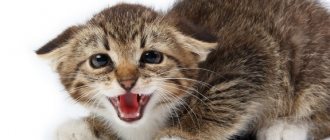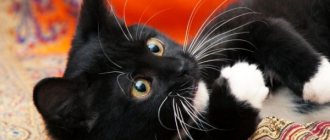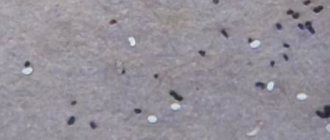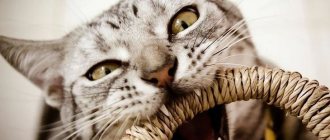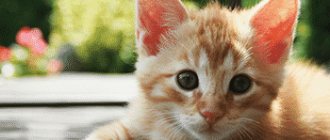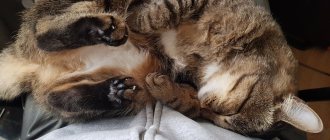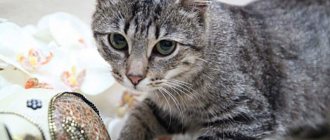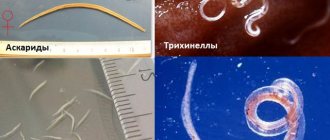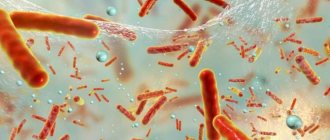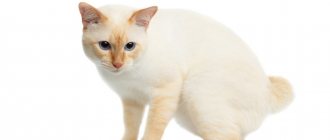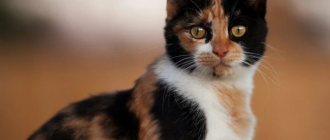Cat colors by type
Abyssinian Point .
A combination of point color and ticking. Agouti . Wild color. With agouti colors, each hair on the cat's body has clearly defined zones - ticking, while the tip of the hair has the color of the main color - typing.
Harlequin . Van color, with additional evenly distributed spots on the body and legs. Intermediate between bicolor and van.
Bicolor (Bi-Colour). Evenly distributed spots of primary color on white.
Van bicolor (Van/Van Bicolour). White color with a colored tail and the same spots on the head between the ears.
Smoky color (Smoke). Single-color version of silver tabbies (typing no more than 1/2 of the total hair length).
color . Silver and golden colors, similar to chinchillas and differing from them in a slightly longer tip length (no more than 1/4 of the total length of hairs). The term "shaded" is also used to refer to this type of color for the red, cream and tortoiseshell variations.
Calico . A combination of tortoiseshell and white without agouti, smoke or silver. The ideal calico color is that spots of different colors should not have common boundaries, but should be separated by white.
Tabby Point . Point color with tabby pattern.
Mitted . White “slippers” on all four paws.
Mink . The body is darker than with the point color, and the tips of the paws and muzzle are even darker.
Weakened color (Dilute). Lightening intense colors of black to blue, chocolate to lilac, red to cream, etc.
Parti-Colour . Tortoiseshell color occupies no more than a third of the body surface.
Pointed . Siamese or Himalayan color - the body is lighter than the paws, tail and ears.
Sepia . Solid color of Burmese cats, an outdated name for the "ivory" color of Siamese cats.
color . Tabby colors are similar to wild colors, but differ from them in the background color (white with a grayish tint, reminiscent of the color of silver).
Solid /Self. The coat color is only one color, without agouti.
Tabby . Groups of cat colors that have a characteristic pattern of stripes and spots on the face, limbs and tail and are classified by the type of pattern on the body.
Ticking . Alternating areas of background (grayish-yellow to bright orange) and base color on each hair of agouti-colored cats. The width of these areas, small at the root, increases towards the tip of the hair. The number of sections is not always the same for different colors and varies from 4 to 7-10.
Tipping . The ends of a cat's fur, usually the same color as its base coat.
Torby . Combination of tortoiseshell and tabby color.
Torbico . A combination of tortoiseshell tabby and white color.
Tri -Colour. Tortoiseshell bicolor; same as calico.
Tortoiseshell color (Tortie). Colors characteristic, as a rule, only of female animals. Alternating patches of black (blue, chocolate, lilac, cinnamon, or fawn) and red (cream) on a cat's coat.
Tortie Point. Point color with tortoiseshell markings.
Chinchilla (Chinchilla). The name of a specific silver and golden color, characterized by an almost complete absence of the usual tabby pattern, a decrease in the size of the main color areas and an increase in the background areas in the ticking, while the typing occupies no more than 1/8 of the total length of the hairs.
More details
The concept of color in cats covers, firstly, the actual color of the cat’s fur, secondly, the pattern of stripes on the fur or its absence, thirdly, the presence or absence of white spots of different sizes on the fur and the order of their location, fourthly, different degrees of wool coloration.
About pigments
The color of a cat's fur, skin and eyes is due to the presence of the pigment melanin . Melanin is found in the hair body in the form of microscopic granules that vary in shape, size and quantity, which causes differences in color. There are two chemical varieties of melanin: eumelanin and phaeomelanin . Eumelanin granules are spherical and absorb almost all light, giving black pigmentation. Pheumelanin granules are oblong (ellipsoidal in shape) and reflect light in the red-yellow-orange range.
Eumelanin is responsible for black color (and its derivatives - chocolate, blue, lilac, fawn, cinnamon), and feumelanin is responsible for red (cream). The genes that are responsible for the appearance of red (O - orange) or black (o - not orange) are located on the X chromosome, that is, the inheritance of color is linked to sex. Cats have two X chromosomes and, accordingly, three color options: OO - red, XX - black, Oo - tortoiseshell (red-black). Cats have one X chromosome and, depending on which gene it carries, O or O, it will be red or black. Tortoiseshell coloring in cats appears only in the case of genetic disorders, and such cats are sterile.
Thus, the inheritance of traits whose genes are located on the X or Y chromosome is called sex-linked. Genes localized on the X chromosome and not having alleles on the Y chromosome are inherited from mother to son, in particular, a red cat cannot be born to a black cat, and vice versa, a red cat cannot give birth to a black series cat.
British Shorthair
Sweet british buns, adored throughout the world, know firsthand what good looks mean. They gained popularity with their soft forms, huge naive eyes, chubby cheeks and the famous “Cheshire” smile that became a household name. A kind, flexible, self-sufficient disposition, called typically English, finished off the skeptics (if there were any). And when the recessive gene of Scottish folds (i.e., Scottish fold cats) was added to the British gene pool, the breed simply blew up the cat world.
Please note: both Britons and Scottish cats can have straight or fold ears. This is reflected in the English names of the branches with the marks “straight” (from the English “straight”) or “fold” (from the English “folded”). There is also a genus of long-haired British cats, which are also very good-looking.
Chocolate lifts your mood. Smile!
Balinese
Named after the graceful dancers from the island of Bali, purrs will win the heart of even the most discerning person. Born of fine-boned, exquisite Siamese (the breed began with the selection of long-haired kittens appearing in a litter of Siamese), they retained their parental stature and sapphire eyes, increasing their wealth with fine silken wool and a melodious, affectionate voice. By the way, Balinese cats readily use it, actively commenting on what is happening around them. Apsaras (the unofficial name of the family) will not tolerate inattention to their thoughts or the august person. Distinguished by their complex character, they demand recognition and strive to be the center of their owner’s world, but they are unlikely to appreciate people’s obsessive attention.
Note: close relatives of the Siamese, Orientals attract attention with their outstanding exterior. It’s not for nothing that they are often called the supermodels of the cat world!
All cats are like cats, but I am a goddess!
Abyssinians
Bred on the basis of indigenous cat breeds of the black continent, the genus is considered one of the most ancient. In addition, he is one of the five first officially registered families of domestic mursaks: the standard was approved in 1882, although since then it has been changed about 20 times. The family's name is inspired by Africa's most mysterious country, Ethiopia (called Abyssinia until 1974). True, many people joke that cats actually deserve their name because of their bottomless, expressive eyes (in English, abyss means “abyss”). Those who buy into the enchanting look should be prepared for the activity of their charges. These purrs are talkative, curious and restless, so you are guaranteed to intervene in all household chores, accompanied by valuable instructions from your four-legged friend.
This is interesting: felinologists claim that it was the proud profile of the Abyssinians that the ancient Egyptians imprinted on the walls. And modern fans of the Bastet cult do not lose hope of securing the beautiful offspring of abyss cats and swamp cats - exotic giants
.
A good portrait on the wall is never too much!
Turkish Angora
Not only Angora sheep are famous for their expensive, fine wool. Cats from this region of Turkey receive just as many compliments for their luxurious, snow-white coats. Given the characteristic plume on the hind legs and bushy tail, they are considered the progenitors of most long-haired European breeds. Friendly, sociable whites do not tolerate loneliness well. But even in adulthood they retain graceful movements and a cheerful, playful attitude. Beauty!
I'm beautiful, no doubt about it!
Somalia
The history of the beautiful Somalis is in many ways similar to the chronicle of the Balinese. Like Apsaras, Red Graces are descended from the long-haired kittens found in litters of Abyssinian cats. They adopted all the outstanding character traits of their ancestors, except for persistence and talkativeness. Regarding appearance, the Somali inherited the rich ticked color (the more pronounced stripes, the more expensive the kitten), stature, grace and amazing eyes of the Ethiopians.
An interesting fact: all the colors of near-Abyssinian breeds are based on red pigment. Even the blue color of the coat is actually sandy (it is not considered solid, because the hair of these purrs is ticked).
Rose of the desert, storm of the seas!
Russian blue
According to legend, Queen Victoria's favorite cats sailed to the shores of Albion from the snowy Arkhangelsk region. Others say that they arrived in England with ambassadors of Catherine II, who loved to present foreign guests with all sorts of wonders. Be that as it may, for a long time in Europe the breed was known under the name “Arkhangelsk Blue”. And the “mother” of the branch, Karen Cox, established the first standard in 1912, having previously associated her angels with green-eyed Pomeranian rat catchers. The well-known name of the genus appeared due to the fact that the war practically wiped out the gray beauties, and the restoration of the population alienated them from Pomeranian blood. After all, in order to resurrect without fussing with the purity of the gene pool, the Rus remaining after World War II were crossed by the Allies with Orientals, Nibelungs, Carthusians, and Britons. And the Russians, who received the “material” during perestroika, decided not to philosophize, mating cats obtained from Europe with local carriers of blue genes. The character depends on the sample (there are 4 in total).
Interesting to know: there are four standards of the Russian Blue cat - European, English, Scandinavian and American. The differences between them lie in the characteristics of the build, for which the breeds chosen for the renewal of hare are responsible. Some call the Rus subspecies the rare, mysterious Nibelungs.
One way or another, I am a person of blue blood!
American Curl
One of the most amazing, rare, recognizable, but unpopular breeds in the CIS deserves a place in our top 10. At least for the unusual, curved back ears that breeders gave to Highlanders, Kinkalows, and Dwelfs. American Curls (from the English curl - curl) come in long, short and medium hair, and the latter look very impressive thanks to the “pants” of the hips, as well as the plume on the tail. All representatives of the genus are distinguished by high trainability, canine devotion and the tenderness of a newborn kitten. Great combination, don't you agree?
Love me, please!
Maine Coon
The famous giants of the cat world, Maine Coons originated in the harsh northern forests of the United States. Rumor has it that their ancestors were angoras sent overseas by Marie Antoinette, who swam across the deep water with the Vikings, stogkatta, lynxes and even raccoons from Maine (it’s all because of the bushy tail, for which the hulks received the name “Maine raccoon”). Genetics proved the natural origin of the genus, which breeders then took up. Thanks to their efforts, there are two types of maines: the American one, more similar to the wild ancestors, and the brutal European one, which blew up the World Wide Web.
A nuance: it is believed that the former have a more sociable and gentle character, and better health, than the latter. But professionals say: everything depends not on the subspecies, but on the percentage of wild genes in the blood of kittens. Therefore, the closer the baby is to its forest relatives, the higher its price.
What are you watching? I am king and god!
Classic Persians
The phrase “Persian cat” is associated with flat-faced and not always cute cat cats. However, only representatives of the extreme type of the breed and the short-haired exotics that have conquered the Internet show off the characteristic look of their faces. Classic Persians look less extravagant, although they also have a shortened muzzle (brachycephaly). The point of the chronicle of oriental wonders is that initially the standard of the breed was the classic version, originating from the Angora crossed with unknown representatives of the feline genus, and the extreme version was developed by American enthusiasts. However, today the second, exotic type is much more common.
The photo is unprofessional, but I am valuable without a price!
In addition to the above-mentioned Murziks, Norwegian Forest, Himalayan, Bengal, Ragdoll, Toyger, Peterbald, Turkish Van, Kuril Bobtail cats have every right to be on the list of the most beautiful ones... it is simply impossible to list all the top models of the cat world! And you shouldn’t write off cute mongrels or cats with special needs either.
For every owner, his pet is always the most beautiful
People don't love you for your appearance or breed
White color
White color is a complete lack of pigmentation. In cats, solid white fur can be achieved in three different cases:
White albino is a recessive variant that is very rare in cats.
Solid white spots - appear under the influence of the white spot factor (S), which is not completely dominant, is subject to polygenetic modifications and usually leads to the fact that the cat is not entirely white. However, the spots may be so dense that the animal appears completely white. White spots are described in the following sections.
Dominant White - This mutation suppresses all other pigmentation genes, and results in a white coat color and blue eyes. As the name suggests, this is the effect of the dominant white gene (W). In the case of dominant white, the genes for other colors and patterns, although present, are completely hidden. The only way to determine the main genotype in practice (before the appearance, conduct a genetic analysis to determine the genotype of the cat) is by crossing with colored cats of a well-known genotype. Breeding two dominant whites will usually result in all-white kittens, but if both parents are heterozygous (W/w), some kittens may show primary colors. If the genotype of the white parents is not known from the pedigree or test crosses, the mating result is unpredictable.
Dominant white is found in a variety of breeds. Sometimes white Oriental Orientals are considered by some associations as a separate breed. The dominant white color has a much deeper blue eye color than albinos, and this is considered an advantage. The best blue eye color is observed in completely white Oriental Oriental cats that carry a suppressed chocolate gene.
Deafness in cats is associated with the spotting (S) and white dominant (W) genes, but not with the albinism gene (c/c or ca/ca).
What diseases are they susceptible to?
In addition to classic cat diseases (formation of stones in the ureter, hairballs getting stuck in the intestines, etc.), representatives of breeding families have a predisposition to characteristic diseases of the breed.
| Breed | Nuances of health |
| Neva Masquerade | Quite healthy cats. The exception is hereditary hypertrophic cardiomyopathy and the problem of fur getting stuck in the gastrointestinal tract, which is common to all long-haired breeds. |
| British and Scottish Shorthairs | Animals with very good health. The only thing you need to pay attention to is the two blood types of British people, which affect the quality of the offspring. Fold-eared individuals may have problems with the musculoskeletal system caused by the gene that lowers the ears. |
| Balinese | Apsaras inherited from the Siamese amyloidosis (protein metabolism disorder), cardiomyopathy, hip dysplasia, and diabetes. Strabismus is common and is not considered a disease. |
| Abyssins | They are quite healthy, but due to improper diet the kidneys often suffer (failure, amyloidosis), and individuals with blue fur often develop polycystic disease. In rare cases, joint dysplasia, retinopathy or a lack of red blood cells may occur. |
| Turkish Angora | Overall a hardy breed. However, due to albinism, partial or complete deafness is possible (in cats with heterochromia, the deaf ear is always on the side of the blue eye), muscle ataxia and heart problems. |
| Somalia | Animals with good immunity. Autoimmune hemolytic anemia (AIHA) is rare. They need daily brushing of their teeth or a special enamel-cleansing food. |
| American Curl | The gene responsible for the shape of the ears sometimes provokes diseases of the musculoskeletal system. Otherwise, curly-eared cats are in good health. |
| Russian blue | The filigree work of breeders provided the Russians with excellent immunity without a predisposition to any diseases. |
| Maine Coons | The heart or joints often hurt, obesity, physical inactivity, and urolithiasis are observed. The body develops slowly, but wears out quickly. |
| Classic Persians, extreme sports, exotics | A flattened muzzle that disrupts the normal arrangement of organs leads to increased tearing and the formation of tartar, breathing problems, and the occurrence of gingivitis. Half of the extreme/exotic livestock suffers from polycystic kidney disease and renal failure. There is also a genetic predisposition to hypertrophic cardiomyopathy, retinal atrophy, and hip dysplasia. |
Agouti and non-agouti
The colors of cats are very diverse. Some cats are evenly colored - these are the so-called solid colors or solids . Other cats have a pronounced pattern - in the form of stripes, circles. This pattern is called tabby . Tabby "opens" on the coat thanks to the dominant gene A - agouti. This gene colors each cat's hair with evenly alternating dark and light transverse stripes.
In dark stripes, a larger amount of eumelanin pigment is concentrated, in light ones - less, and the pigment granules elongate, acquiring an ellipsoidal shape and are located sparsely along the length of the hair.
But if a homozygous allele (aa)—non-agouti—appears in the genotype of a black animal, the tabby pattern does not appear and the color turns out to be solid. This influence of some genes on other genes that are not allelic with them is called epistasis. That is, the allele (aa) has an epistatic effect on the tabby genes, it “covers” them, masks them, and prevents them from appearing. At the same time, the effect of allele (aa) does not extend to the O (orange) gene. Therefore, cats of red (cream) color always have an open tabby pattern, and the solid red color in cats is obtained through the breeder's breeding work, when selection is made for wider dark-colored stripes, the close proximity of which is perceived by the human eye as a solid red color.
Thus, all cats are tabbies, but not all are agoutis . Confirmation that all cats have a tabby in their genotype is the residual “ghost” baby tabby in many kittens. This residual tabby in cats of solid colors goes away, the cat sheds, the coat changes and becomes evenly colored.
Zoned hair coloring under the influence of the agouti gene
Care and maintenance
The basis of care is a balanced diet.
When purchasing a kitten, you need to ask the breeder what food the animal is accustomed to. Using this food, you can gradually switch to the desired mode. Up to four months, the kitten should eat at least four times a day, after 8 months - twice. If the animal receives natural food, it should include fermented milk products, offal, and lean meat. Do not give cream or natural milk. The former have a high fat content, and the latter is not absorbed by the body of an adult cat. Suitable by-products include chicken gizzards, hearts, and beef liver. Meat – chicken, veal, turkey, rabbit. Pork has a high fat content and can lead to excess weight gain.
As a side dish - porridge. You can give your cat buckwheat, oats, rice. It's great to include vegetables in your diet. They can be raw or boiled. Fish can only be sea, low-fat, boiled. The finished food has a balanced composition, containing all the substances a cat needs. The food can be dry or wet. It is better to choose premium, super-premium, holistic food.
Veterinarians strictly prohibit mixing these two regimens. This can cause problems in the digestive system. Many Scottish dogs are prone to overeating. You should not overfeed your pet - extra calories weaken the heart system. Also, care is important for a cat, which consists of certain hygiene procedures.
brindle tabby
Education and training
A pet is not a soft toy. When bringing home a Scotsman, you need to know the basic rules of communication, keeping, and raising a pet. This breed has developed intelligence and quick wits. You can teach your kitten to simple commands, but you need to know some nuances. A kitten left alone can cause mayhem and chaos.
There is no need to hit or scream at the animal. It will not understand what the owner wants from it. You need to set aside some time and devote it to your pet. You need to buy toys for him, a play corner, tennis balls are perfect. The kitten perceives them as its prey. If you play with him during the day or in the evening, at night the pet will sleep peacefully without disturbing people.
If the kitten starts biting or chewing furniture, this must be strictly stopped. This can be done in a stern voice. If the furniture is suffering, it can be treated with sprays with the smell of citrus fruits; cats cannot tolerate such aromas. Scottish Folds get accustomed to the litter box very quickly, you just need to show them the place of the toilet. Kittens usually understand everything the first time.
Ticking and Tabby
Agouti is a phenomenon of zoned hair coloring. Each hair is divided into several zones, each of which is colored to varying degrees: some zones are more intensely colored, others less or not colored at all. The group of agouti colors in cats includes tabby, shaded, and chinchilla colors. Agouti colors are found in many species of animals: hares, gerbils, chinchillas, guinea pigs, etc.
Tabby is a fur pattern. All tabbies have fine lines on their muzzle that define their eyes and form an "M" on their forehead. If you look at the fur close up, you can see that each hair is colored with dark and light stripes. This alternation is called "Agouti". It is generally accepted that tabby is the original color of cats, therefore it is otherwise called “wild color”, i.e. characteristic of small wild cats.
Tabby mackerel is a tiger-striped fish with a pattern of parallel vertical stripes.
Classic tabby, marbled tabby - wide spiral stripes on the sides, reminiscent of marble stains, three stripes along the ridge, spotted belly, ring-shaped stripes on the tail and paws.
Spotted tabby - evenly spaced small spots throughout the body. The spots may appear in the form of intermittent stripes.
Ticked tabby, Abyssinian tabby or agouti tabby - no stripes or spots on the body, but with a pattern on the face and agouti on the body. This color is typical for the Abyssinian cat breed.
Cat hair with ticked shaded color
Cat hair with smoky color
Cat hair with shaded color
Cat hair with shaded red (cameo) color
Shaded
Shaded cameo/veiled cameo - kittens are born white, then tipping (coloring at the ends of the hair) gradually appears.
Silver Shaded/Chinchilla - Kittens are born with a dark or striped pattern, especially on the tail, which fades by 4-6 weeks. A chinchilla kitten can be so light that it appears white, but since neither parent is white, the kitten cannot be white. Green eyes in a white cat with silver parents is a sure sign that she is a chinchilla and not white.
Blue color
Shaded Tortoiseshell/Veiled Tortoiseshell - A cat may look like a silver black shaded or black chinchilla, but have a tiny spot or even a few hairs of cream or red, or have mottled black and cream paw pads. However, this difference will make your cat shaded or veiled tortoiseshell, not chinchilla or silver black shaded.
Group of solid colors
Black - black color, with well-dyed hair to the roots, without patterns or light spots.
Red - dark red color, with well-dyed hair to the roots, without patterns or light spots. The nose and paw pads are brick red. Eyes - copper or dark orange.
Cream - uniform color, any marks and stains are unacceptable. The creamy color covers each hair evenly down to the root. The undercoat should not be light or white. The nose and paw pads are pink. Eyes orange or copper.
Blue is a gray shade of the coat, preferably light, clean and uniform, without shades or hairs of a different color. The nose and paw pads are bluish-gray. Eye color is orange or green.
Blue Cream Tortoiseshell - Light blue and cream colors mixed throughout the body and limbs. The nose and paw pads are pink, bluish-gray or pink with bluish-gray spots.
Chocolate
Caring for a pregnant cat
Scottish cats themselves take precautionary steps during pregnancy, lead a sedentary lifestyle, and are extremely neat and clean. The owner needs to help the cat during this period, follow simple rules:
- Transfer to extra-premium food from specially developed lines for pregnant and lactating cats.
- It is strictly forbidden to treat Scots with medications without the recommendation of a veterinarian.
- Do not palpate the cat yourself; you may harm the embryos. A specialist uses an ultrasound to determine the gestational age, the number of embryos, and the approximate day of birth.
- Street walks are prohibited to prevent the pet from becoming infected with infectious diseases. Ventilate the room more often, but protect the tartan from drafts.
Nutrition
The cat’s diet does not change, only the volumes and quantities are adjusted, minerals, vitamins, and a lot of protein are added.
- after 3 weeks, the increased portion of food is divided into 4 doses;
- by the middle of pregnancy, they gradually double the daily portion of food, but do not make the cat become obese, which can complicate childbirth;
- in the final stage before childbirth, they return to the normal diet that they had before pregnancy.
After giving birth, the cat needs simple food that is digestible by the body. The cat is fed up to 5 times a day, fish oil, calcium and phosphorus supplements are added to the food, and milk and fermented milk products are given.
Piebald colors
Different degrees of manifestation of the white spot factor in piebald colors. Piebald color is a manifestation of the white spot factor or otherwise piebald. Piebald colors are characterized by the arrangement of colored spots on a white background. Depending on the degree of manifestation of the white spotting genes, colors are distinguished:
Van - (maximum degree) all white with a colored tail and 1-2 small colored spots on the head above eye level and below the ears. A small colored spot on the shoulder area and small spots on the back of the limbs are also acceptable.
The Harlequin is primarily white with a few small colored spots located on the body and limbs.
Bicolor - most of the skin is dark, and a smaller part is uncolored, white, in an indefinite ratio.
Among the bicolors, the following colors can be distinguished:
With white gloves - with white spots covering the bottom of the paws
With a white medallion - a white spot on the chest
With white buttons - one or more small white spots
Tuxedo (tuxedo) - with white paws and chest. May have a little white on the head. This is an informal definition.
Calico is a combination of tortoiseshell and white, with white being the predominant color.
Cat breeds with tortoiseshell color
Of course, tricolor kittens are also born to outbred cats, but if a person is seriously interested in purchasing a tortoiseshell-colored pet, it would be useful to know in which breeds this color is standard. We suggest getting acquainted with the most common and popular breeds, within which “turtles” appear most often.
Tortoiseshell color is found in outbred cats
British cat
These aristocratic representatives of the cat world look great in tortoiseshell color. There are many variations of the tri-colored British, they are found in the “tortie” type, and in the “calico” and “turtle on white” variations. Breeders distinguish more than eighty types of colors included in the tortoiseshell group: black-red, beige-blue, cinnamon red, chocolate peach and the like.
British tortoiseshell cat
Oriental cat
The Oriental breed is represented by the largest number of colors in the entire cat world. These sociable, intelligent cats are carriers of one of the most beautiful tortoiseshell colors. Like the British, Orientals have more than fifty varieties of tortoiseshell tricolor: a kitten can wear a warm or cool coat, a patterned or checkerboard coat.
Oriental cake-colored kitten
Maine Coon
The handsome Maine Coons also come in a variety of colors, including tortoiseshell. In the breed you can find dozens of bizarre variations in how shades of black and red are located on the cat’s fluffy fur coat. There are also almost black individuals with barely visible white and peach hairs. It is not uncommon for Maine Coon kittens to have a “turtle on white” appearance.
Small Maine Coon, tortoiseshell color
Canadian Sphynx
Canadian Sphynxes, whether hairless, velor or brushed, can be carriers of the “tortoiseshell” color. In hairless cats, this coloring is even more interesting, since not only the millimeter-long, down-like colored fur is visible, but also the multi-colored skin of the animal. Sometimes the tortoiseshell color does not extend to the entire body of the animal, but only to the face - then the bald cat looks as if she is wearing a mask made of colorful material.
Tortoiseshell velor sphinx
Cornish Rex
Curly-haired Cornish, which have the most delicate fur covered with curls, also represent a breed group, which according to the standard includes tortoiseshell color. Especially among Cornish Rexes, variations in coloration “turtle on white” are valued, when the lower part of the animal’s body is covered with snow-white fur, and on top there are red and black spots.
Tricolor Cornish Rex kitten
Persian cat
Long-haired tortoiseshell cats look very interesting, because in this case not only the pattern, but also the texture of the hairs is taken into account. In Persian cats, the tricolor sections of the coat are intricately mixed, and the hairs can have different shades along the entire length. Turtle Persians typically have beautiful dark orange eyes that look like jewels against their colorful fur.
Longhaired Persian cat "tortie"
Norwegian cat
Norwegian forest cats, according to many, are the most spectacular representatives of the tortoiseshell color. Animals with the “turtle on white” type are more common. Thanks to their long, very lush and rich coat, Norwegian Forest cats boast unusual color transitions and layers of shades.
Norwegian forest turtle
Scottish fold cat
Funny cats, seemingly devoid of ears, in tortoiseshell color are especially reminiscent of a forest owl. This breed is related to the British and therefore has similar types and shades of tricolor. The coat of a Scottish cat can have both cold charcoal and warm chocolate shades. More common are motley cats, the “torti” subspecies, with very rich, bright coat pigments.
Scots Fold, "torty" color
Turkish Angora
Despite the fact that Turkish Angoras were bred as completely snow-white cats, over time, breeders introduced various types of colors, including tortoiseshell. Among Angora cats, the “tortoise-on-white” type is especially common, with the light coat having a particularly vibrant whiteness. The colored areas of the fur coat are usually bright and saturated.
Turkish Angora Tricolor
Silver colors
The group of silver colors is characterized by lightening a certain area of each hair to white. Lightening is caused by the influence of the dominant silver gene I (Sv).
Smokey - approximately half the length of each hair is colored, and the rest is white. Those with a smoky color are sure to be non-agouti; that is, they are homozygous for the recessive gene a, which prohibits the manifestation of the pattern. Residual stripes, “moire” for smoky cats are a color defect.
Black smoky - black with white roots.
Blue smoky - blue with white roots.
Chocolate smoke - chocolate with white roots.
Lilac smoky - purple with white roots.
Red smoky - red with white roots.
Colors of cats that carry the silver gene and are carriers of the agouti A gene, which allows the appearance of the pattern:
The silver tabby is a patterned cat on an all-white background. Each hair is colored zonally: the lighter stripes are lightened to white, the darker stripes retain their original color.
Shaded - 1/3 of the tip of the hair is colored, the rest is white.
Chinchilla - 1/8 of the tip of the hair is colored, the rest is white.
Silver tabbies, shaded tabbies and chinchillas can be either black or blue, chocolate, lilac, etc. For example:
The Black Silver Tabby is a cat with a black pattern on a white background.
The Blue Silver Tabby is a cat with a blue pattern on a white background.
Chocolate Shaded - a white cat with chocolate tips of the hair, one-third dyed.
The Blue Chinchilla is a white cat with 1/8 dyed blue tips.
Cameo is a word that is traditionally added to the name of a red or cream shaded, chinchilla or smoke coat. For example: “red shaded cameo.”
A little about genetics
It is especially interesting how the color of a Scottish kitten is formed and what it depends on. In the genome of this breed, two colors predominate, responsible for the color of the animal - red and black. Anyone can, under certain conditions beyond a person’s control, become dominant. Such a gene suppresses weak ones, which are called recessive. There is also a third gene, the so-called diluent. It is responsible for the degree of pigmentation saturation.
When these genes are combined with each other, the most unusual coat colors of an animal can appear. It is extremely difficult to determine in the first weeks what color a kitten will have in the future. The shade he was born with is not constant and may change as he grows older. In some cases, dramatic changes occur. The change in shade begins at six months and lasts up to two years. The table below shows options for crossing the colors of parents, according to which their offspring inherits the coat color.
How the coat colors of the offspring are crossed.
Color standards and disqualification
Professional systems of felinologists where the Scottish Fold cat breed is recognized: WCF, CFA, TICA, ACF, ACFA. They all have their own characteristics, but in general there is a set of color standards for the Scottish breed. If an animal does not comply with them, it is disqualified from all breed shows and competitions and cannot be allowed to breed. Of course, a cat disqualified for color can have offspring if the owner does not want to sterilize it. But her kittens will never have a pedigree that is recognized among breeders.
Table of Scottish cat colors and disqualifications.
The variety of colors of Scots is huge. To obtain such a palette, the breeder needed decades of crossings with other breeds similar in genotype. Today, crossing with other breeds is practically not used (unless we are talking about Scottish Folds), since the Scots have already received a stable set of genes necessary to continue their pedigree.
I like1I don't like1
Cost of Scottish Fold
When buying Scottish Fold kittens, it is important to keep in mind that longhaired Folds (Highland Fold) cost up to 2 times more than shorthaired ones. Average prices for Scottish Fold kittens in Moscow are:
Average prices for Scottish Fold kittens in Moscow are:
- Without pedigree: from 4,000 rubles
- Standard: from 10,000 to 40,000 rubles
Video
Sources
- https://ru.wikipedia.org/wiki/Scottish_fold_cathttps://dogcatfan.com/155-scottish-fold.htmlhttps://kot-pes.com/shotlandskij-vislouxij-kot-foto-komok-schastya/https: //petsik.ru/catbreed-scottishfold.htmlhttps://murkote.com/skottish-fold/
Pros and cons of Scottish Fold cats
The advantages of the Scottish Fold are:
- appearance;
- thick plush fur, reminiscent of a plush toy;
- calm character;
- cleanliness;
- learning ability
color point scottish fleed
They also have their disadvantages:
- ear parasites due to their characteristic shape;
- picky eating;
- independence from the owner.
As you can see, Scottish cats have more advantages. These animals cannot stand loneliness, for them it is psychological pressure, the animal can become depressed and refuse to eat. Kittens and young individuals are especially vulnerable. Communication with people is critical for them. The character itself is phlegmatic, calm, without excessive activity. At the same time, they are affectionate, patient and good-natured.
I like2I don't like
Shaded colors
The undercoat is almost white, the ends of the hairs are whitish. Almost the entire edge is covered with one color or another, only the chin and abdomen are completely light.
Shaded can be:
Golden. The undercoat is light peach, the fur has a golden glow. The eyes are green, the paw pads and nose are dark chocolate.
Silver. The undercoat is snow-white, the tips of the hairs are dark gray. The eyes are greenish, edged with black. The last feature is characteristic only of the silver variety; other Scottish shaded colors do not have eyeliner. The nose mirror is brick-colored. Black edging of mouth and nose, pads.
Red, aka Cameo. This variety of shaded color has a snow-white undercoat, and there is a dark red coating on the coat. Only the muzzle and chin, the abdomen and the underside of the tail remain completely light. The eyes are like amber. The nose, eyeliner and pads are pinkish.
